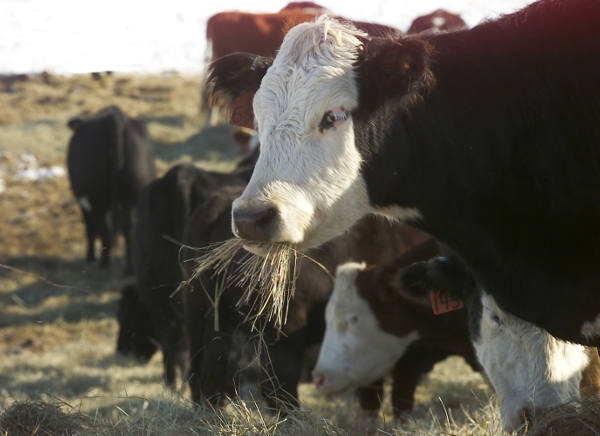July 20, 2012

Understanding and avoiding heat stress in cattle can be a valuable management tool in Oklahoma, where most areas of the state experience 70 or more days each year with temperatures that exceed 90 degrees Fahrenheit.
“Cattle have an upper critical temperature that is approximately 20 degrees Fahrenheit cooler than humans,” said Greg Highfill, Oklahoma State University Cooperative Extension area livestock specialist. “When we’re uncomfortable at 80 degrees and feel hot at 90 degrees, cattle may well be in the danger zone for extreme heat stress.”
The potentially bad news does not end there. Humidity is an additional stress that intensifies ambient temperature problems by making body heat dissipation more difficult. In other words, it can be tough to cool off in Oklahoma during the summer, for people and cattle.
High humidity contributes to the likelihood of heat stroke or prostration because water evaporation from the oral and nasal cavities is decreased, in spite of rapid panting, a heat regulatory device in cattle.
“Since cattle sweat very little, the primary mechanism they have to remove internal heat is by breathing the warm air out of their body, which is accomplished much more efficiently in low humidity environments,” Highfill said.
Signs of heat stress include slobbering, heavy panting, open mouth breathing and lack of coordination. Severe cases may include depression and trembling that require some type of low stress intervention.
“If water is applied to cattle for cooling, it is important that a large droplet size be applied,” Highfill said. “Misting water does not reach the hide and only adds humidity to the breathing environment.”
Provide cool water
Fortunately, overheating in cattle can be prevented under most management conditions. Allowing cattle access to cool water and mineral supplements is a must during hot summertime weather.
“If possible, producers should increase the number of watering locations in a pasture utilizing temporary troughs or tubs,” said Nathan Anderson, Payne County Extension director and agricultural educator. “Cattle tend to bunch up around watering areas, which will reduce air flow and increase heat stress.”
Extra watering troughs or tubs will scatter the cattle over a larger area and into smaller groups. Also, be aware that water consumption will increase by more than 50 percent when temperatures are at or above 90 degrees Fahrenheit.
“Check water sources frequently and have a back-up plan in place to ensure water availability for each pasture,” Anderson said.
Access to shade and air circulation should be provided, if possible. If natural shade is not available, producers should construct suitable structures.
“Ideally, the shade material would be mounted on a frame with the material at least 10 feet in the air and open on all sides,” Anderson said. “Air flow is critical to provide maximum cattle cooling and comfort.”
If the unit is portable, producers can move the structure to reduce the “mud-hole effect” that can develop around permanent structures.
“For cattle in a confinement lot, light-colored bedding is cooler to lie on than bare, dark soil,” Highfill said. “Also, feeding confinement cattle later in the day allows the heat produced by rumen function to be dispersed at night when it is cooler.”
Anderson added that it is a good idea to work cattle before 8 a.m. during hot weather, and all cattle work should be completed by 10 a.m.
“While it may seem to make sense to work cattle after sundown, they may need at least six hours of night cooling before enough heat is dissipated to enable them to cool down from an extremely hot day,” he said.
Cattle that must be handled during hot weather should spend less than 30 minutes in the working facility, according to OSU recommendations. Drylot pens and corrals loaded with cattle will have little if any air circulation.
“Cattle will gain heat constantly when in these areas,” Anderson said. “By limiting the cattle’s time in a working facility, the producer can help limit the animal’s heat gain and therefore the heat stress.”
Again, the most basic rule is to make every effort to provide cattle access to cool, fresh water, especially for animals that are in close, confined areas for any length of time.
“During hot weather, cattle will drink more than 1 percent of their body weight per hour,” Anderson said. “Producers need to be certain that water supply lines are capable of keeping up with demand when working cattle during hot weather.”
Excitable cattle will be even more prone to heat stress if handled at high environmental temperatures.
“If animals are going to have limited access to water under stressful conditions such as shipping by truck or trailer, they should be allowed water prior to further stressful situations,” Anderson said.
Anderson and Highfill point out that it is fortunate most cattle handling for health and production purposes in Oklahoma typically occurs in the relatively cooler weather of spring and fall, resulting in a reduced need for cattle handling in the heat of summer.
“Drought conditions may increase the incidence of handling cattle in summer,” Highfill said. “These drought-affected producers need to be extra vigilant that their livestock does not suffer heat stress.”
The total value of all cattle and calves in Oklahoma was $4.4 billion during the latest available statistical year, making cattle “dollars on the hoof” to local and county economies.
You May Also Like




